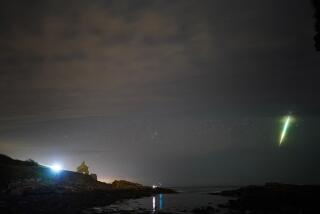New meteor shower may peak this week: Why we haven’t seen it before
- Share via
There’s a new meteor shower coming this week. Maybe!
From midnight to dawn PDT on Saturday morning, Earth might pass through a stream of debris left in the wake of a comet hundreds of years ago.
The result could be a spectacular light show with as many as 200 meteors falling gracefully toward Earth per hour. Or, we might see nothing at all.
The maybe meteor shower has been dubbed the May Camelopardalids (Camel-Oh-par-dalids).
“For all our computer models and equipment, we astronomers are just like the average sky watcher in North America,” said Bill Cooke, who heads up the NASA Marshall Space Flight Center’s Meteoroid Environment Office. “We can’t tell you what will happen.”
Peter Jenniskens, the astronomer who first predicted the maybe meteor shower a decade ago, put it this way: “It’s science. It’s exploration.”
Most meteor showers occur when Earth orbits through a trail of dust shed by a comet as it makes its own way around the sun. That dust burns up in our atmosphere, and causes what looks like shooting stars to streak across the sky.
In the case of this weekend’s maybe meteor shower, the dust responsible for the meteors would have been shed hundreds of years ago by a relatively small periodic comet called 209P/LINEAR that was discovered in 2004. However, scientists don’t know how much dust the comet left in its wake.
Today, the comet is only weakly active, which means it is not shedding much of anything as it orbits the sun. If it was similarly anemic 200 or 300 years ago, then we won’t get much of a show.
“That is the big mystery,” said Jenniskens. “We don’t know what the comet was doing hundreds of years ago.”
Up until now, Earth has never had the opportunity to pass through this hypothesized centuries-old debris stream. The comet’s 5.1-year-orbit takes it out by Jupiter, where the gas giant’s gravity alters the comet’s orbit. And because a comet’s dust stream moves along a similar orbit to its parent comet, Jupiter’s gravity has also acted on this dust stream.
“If you look at the models, Jupiter’s gravity has tugged this stuff into the Earth’s path this year, but by next year, Jupiter’s gravity will have pulled it away again,” said Cooke.
So, early Saturday morning may be your first and last time to see the Camelopardalids--the potentially great, maybe meteor shower of 2014. No one is going to guarantee you will see a show, but wouldn’t you hate to miss it if there is one?
The Camelopardalids shower should peak between midnight and dawn on Saturday. If it is visible at all, it will be visible across North America. Astronomers suggest looking up between 11 p.m. Friday night to 1 a.m. Saturday morning PDT for your best chances to see the shower.







